For some reason hubbie and I have an aversion to organised tours. Despite the potential benefits of local knowledge and insider information, the thought of spending the day being herded around with all the other tourists (who will of course no doubt be loud, obnoxious and ignorant) brings us out in a cold sweat every time. Which means that the ‘Cappadocia Undiscovered’ day tour we did with Turkish Heritage Travel had to be bloody brilliant for us to even contemplate tagging along.
A small sigh of relief accompanied the ridiculous but necessarily little jig I was performing in my mind as I counted only 6 faces staring curiously out of the minibus at our approach. We could probably cope with such a small number, and none of them had 3 heads by the looks of it.
There are lots of tour companies in Goreme all offering pretty much the same day trips, but we opted for Turkish Heritage because their website was the best, the reviews were many and positive, and they are affiliated with the Kelebek Cave Hotel where we were staying. Plus the office was just down the hill from our room, handily next to Butterfly Balloons who we’d flown with the previous day.
The History Bit
The Cappadocia Undiscovered Tour is all about bringing history to life and releasing that inner archaeologist, so here comes the history bit, now concentrate…
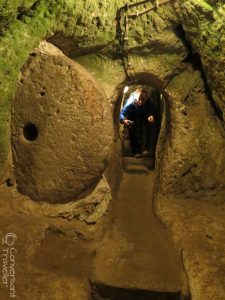
Sitting uncomfortably in ‘no-man’s land’ in between Europe and Asia, the Central Anatolian area of what is now Turkey came under frequent attack from marauding armies of Assyrians, Greeks, Persians, Goths (no, not that sort), Macedonians, Celcucks, you name it… The local inhabitants grew accustomed to the invasions and developed an ingenious secret underground existence of caves, tunnels, hidden rock churches and eventually entire cities built beneath the ground so they could evade capture.
And if you’re visiting the area, you really ought to know how Cappadocia got it’s name: The word ‘Cappadocia’ means ‘land of beautiful horses’, a label given by the Persians after forcing the Cappadocians to pay them a tribute of 1500 horses during the 6th – 5th Century BC. Having seen the state of some of the horses around Goreme today I can only suppose things have changed tremendously since those days. I think I’d rather accept a tribute of Cappadocian wine than any of the poor scrawny beasts we saw during our week there.
Mustafapasa
Our first stop was the small town of Mustafapasa, the former Greek village of Sinasos. It wasn’t much to look at on the surface, but listening to our guide Ferai superbly peeling back the layers of history with her engaging tales brought the village to life in a way only a local could.
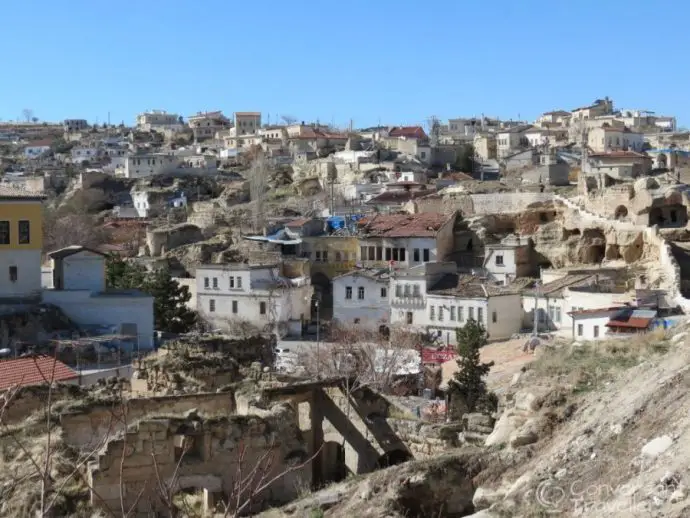
I’d read all about the forced population exchange between the Greeks and the Turks (in Victoria Hislop’s The Thread) but actually standing somewhere it happened made the episode all the more real. In order to resolve religious and political conflict in this area of the Ottoman Empire, in 1924 all Orthodox Greek inhabitants of Mustafapasa were forcibly exchanged with Muslim Turks from Greece, having been given just a few days notice to pack belongings and sell their houses. Takes me more than a week to pack for just a short holiday so goodness knows how they managed it!
I have to say the town itself wasn’t particularly absorbing, although there was Ayios Kostantino, an old church (when isn’t there an old church!!) and surviving examples of Greek architecture on some of the buildings.
I reminded myself we were doing the ‘undiscovered’ tour so it wasn’t going to be fairy chimneys all the way. What struck me most was that the place felt deserted, like perhaps the houses were still waiting for their new occupants. Sure it was winter, and we didn’t see another tourist all day (whoop whoop) but it did give it an eerie feeling.
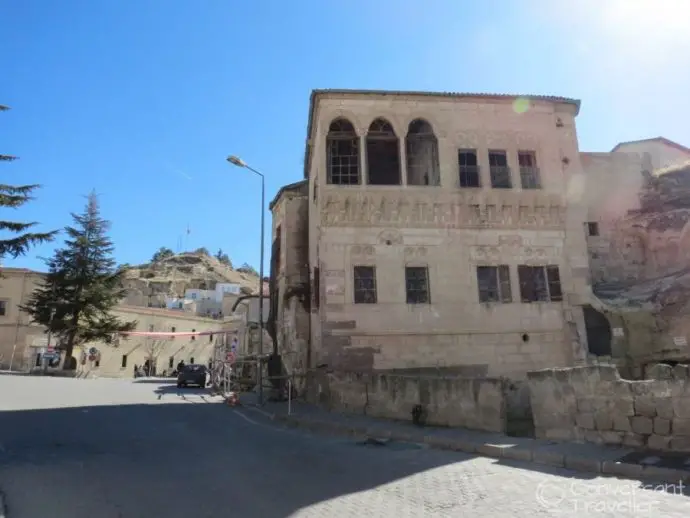
Before the mass migration, the Greeks of Mustafapasa were known for their trading in seafood from Istanbul. Today the population of the surrounding area is mainly involved in potato cultivation, with huge extended families living together in massive houses and all working in the business to cut down labour costs. The potatoes are stored inside cool caves big enough to fit tractors inside! Apparently this means the crops keep their flavour and the sulphur in the volcanic rock ensures they retain their moisture. But you didn’t come here for a lesson in agriculture.
The landscape opened up on the next part of the trip, with long roads stretching as true as an arrow and as far as the eye could see, guarded by distant volcanoes on either side. The rather harsh and arrid landscape would no doubt be greener in the summer, but for the life of me I couldn’t really envisage the apricots and grapes that the area is so famous for. Seeing the stubbly dusty ground it’s no wonder Turkish wine is so bad!
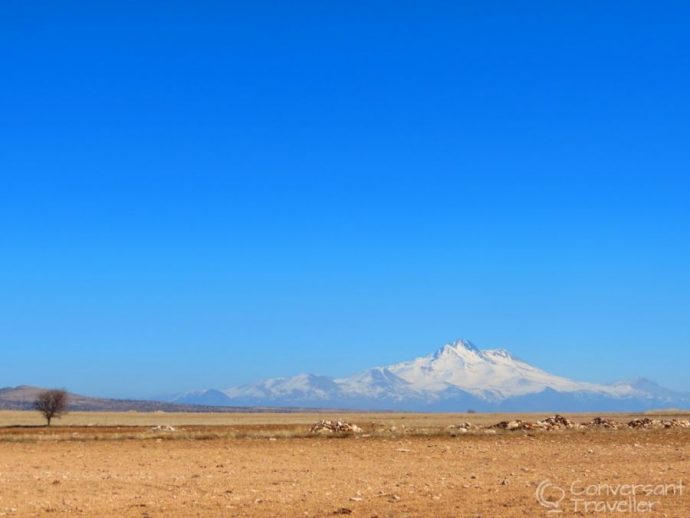
Sobesos
The locals are rightly very proud of their recently discovered Roman site of Sobesos, near the little village of Sahinefendi. It’s the only Roman archaeological site in the whole of central Turkey and, you guessed it, was discovered by a farmer ploughing his fields.
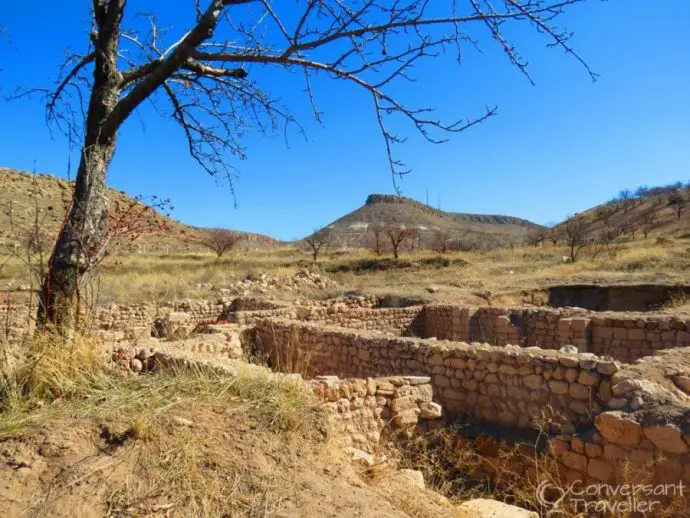
If you didn’t know it was there, you’d miss it, tucked quietly in the corner of a field down a dirt track in the middle of absolutely no-where. It’s still a work in progress and being slowly excavated by university students when funding allows, but the fact it hasn’t been turned into a glossy visitor attraction and is still very much ‘the real thing’ just makes it all the more rewarding an experience.
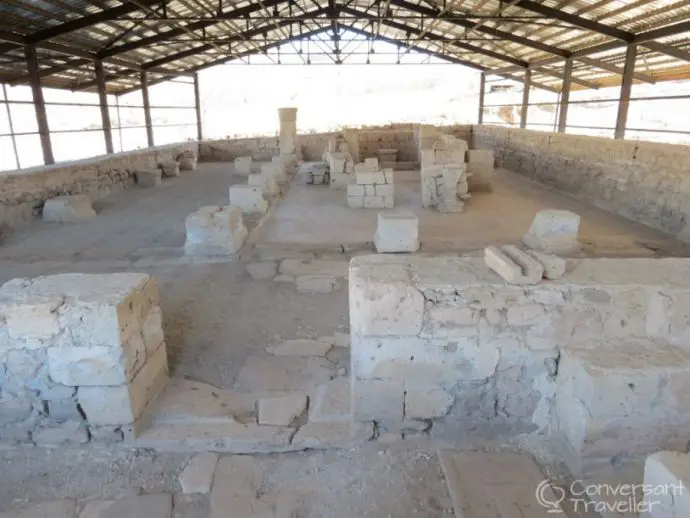
We’ve done Roman ruins to death over the years but this little place was different, and I almost don’t want to tell you about it so it remains a secret.
Soganli Valley
My favourite part of the day was the serenely peaceful Soganli Valley (pronounced ‘Soh-WAN-li’).
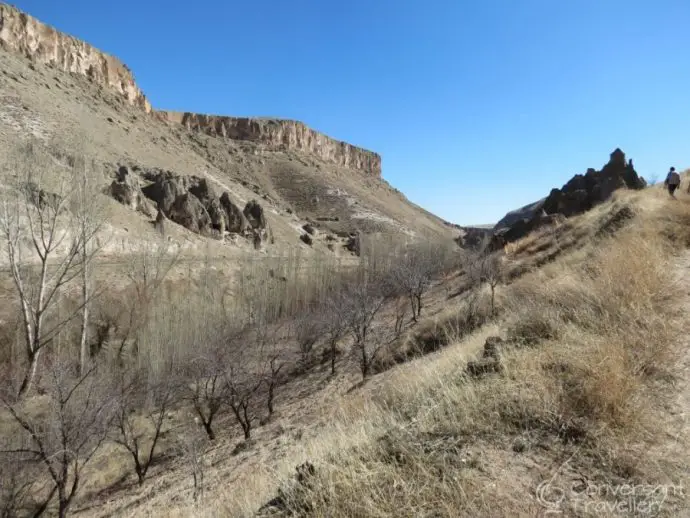
Walking down the arid valley in winter it was all about the rock, with sheer cliffs, plateaus and hidden churches peppered all along the pathways.
The rock cone churches date from the 9th Century and were originally used by the Romans for burials, then later by the Byzantines as places of refuge and secret worship. From the valley below you’d never know they existed. Which I suppose was the point.
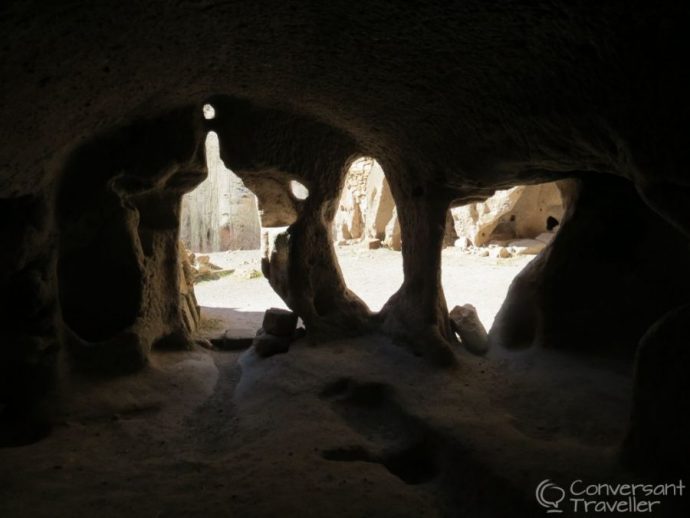
Many early Christians fled persecution and settled in Cappadocia where they built some of the earliest churches and painted stunning frescoes that still remain today.
Some later ‘artists’ have also added their own touches in several of the churches, and whilst some is simple graffiti, a lot are actually messages of love and respect left by Greeks visiting the lands of their ancestors.
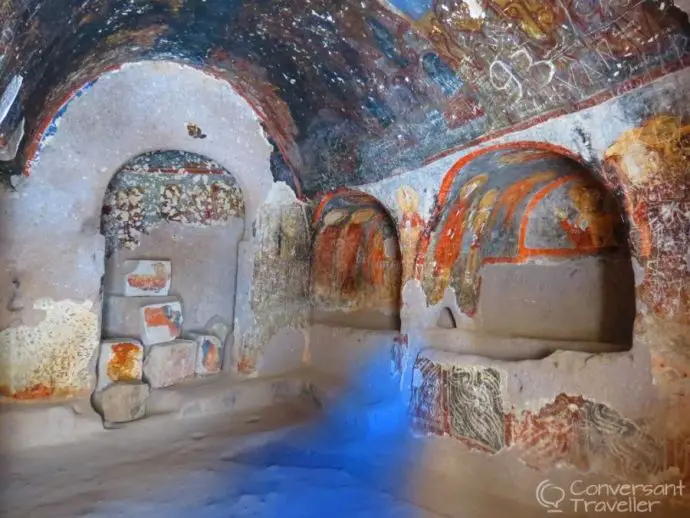
Yilanli Kilise (‘Snake’ Church, above) was so-called because the Turks misinterpreted the Byzantine frescoes of St George and the Dragon as a snake (they’d never heard of dragons!).
Other churches worthy of exploration are the Kubbeli Kilise (‘Domed’ Church, below) and the aptly-named ‘Hidden’ Church.
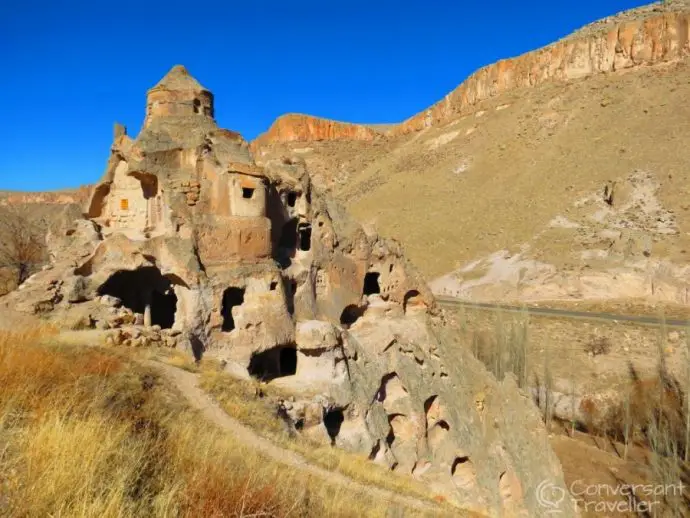
Interestingly nearly all the faces in the frescoes we saw in Cappadocia had been scratched out. Initially I suspected an enthusiastic vandal with OCD, but hubbie sensibly pointed out it would have been done by Muslim Turks after the Christians had left, since Islam forbids an image of Allah incarnate to be depicted in any form. Including people and their faces.
Some of the highest painted ceiling frescoes were left untouched, presumably they just didn’t have a tall enough ladder. Talk about half a job!
Just before reaching the valley we’d driven past a load of ugly institutional prefab huts, looking more like a refugee camp than a place of permanent habitation. Turns out the government in their infinate wisdom deemed Soganli village too dangerous to live in due to a landslide in the 1990s, and had ordered the inhabitants to leave. Supposed to be ‘temporary’, the huts are still there today, and the inhabitants forgotten. A couple of families have rebelled and moved back into the valley (which doesn’t look more dangerous than anywhere else!), and are enjoying the solitude of the pretty village and the occasional trade from passing tourists.
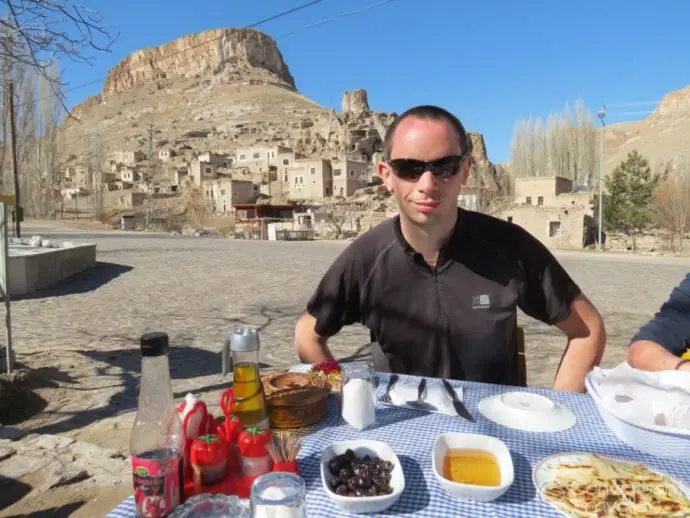
We all obliged by eating a hearty lunch at Soganli Restaurant, one of the best meals we had in Turkey! Being the only patrons it was perfect sitting out in the sun at long tables covered with delicious dishes. And we couldn’t complain about the view. No-one really wanted to leave, but an underground city was calling us from the depths.
Derinkuyu Underground City
So we’ve seen caves, fairy chimneys and even cave churches, but even more mind-boggling are the underground cities hidden deep in Cappadocia’s rocky foundations. There are thought to be over 100 in the area, with only 36 excavated to date. These cave cities initiated by the Hitties many moons ago were expanded over the centuries by different civilisations, all for the same purpose, protection from invaders.
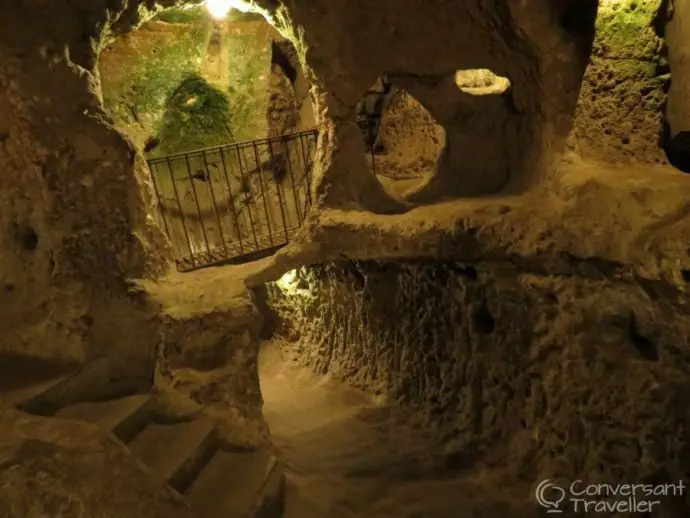
Derinkuyu is the deepest underground city at 85m, with 8 levels, 7 of which are accessible to the visitor. There is pretty much everything you’d expect to find in order to support the inhabitants, including churches, stables, kitchens, storage rooms, and even missionary schools.

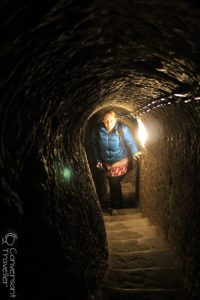
It was fun if a little cramped to explore the dark tunnels. Some of the narrow passages down to the deeper levels had us all walking hunched like frogs, not least hubbie who was several inches taller than the rest of us. Would’ve certainly made it harder for any attackers, in much the same way as English castles being built with spiral stairs giving the advantage to a right handed swordsman defending from above.
Personally I think the stink coming from the cattle caves on the upper levels (which were also used as a toilet by the inhabitants!) would be enough to put off any potential attackers. The builders were crafty in their deception, disguising air holes to look like wells from above, and ensuring all chimney funnels were staggered and disjointed so the smoke from cooking fires dispersed above ground less obviously.
They used large mill stones (created underground as they were too large to have fitted through the tunnels) to block up entrances, and dug pits in the floor that would’ve ended badly for an enemy stumbling around in the dark, but the most igenious and clearly very necessary addition to this underground city was the winery (left), complete with all facilities and storage to ensure they never went thirsty and to while away the long dark days and nights.
Personally I think I’d rather take on an intruder than drink that stuff, but each to his own. Do I keep mentioning the wine?
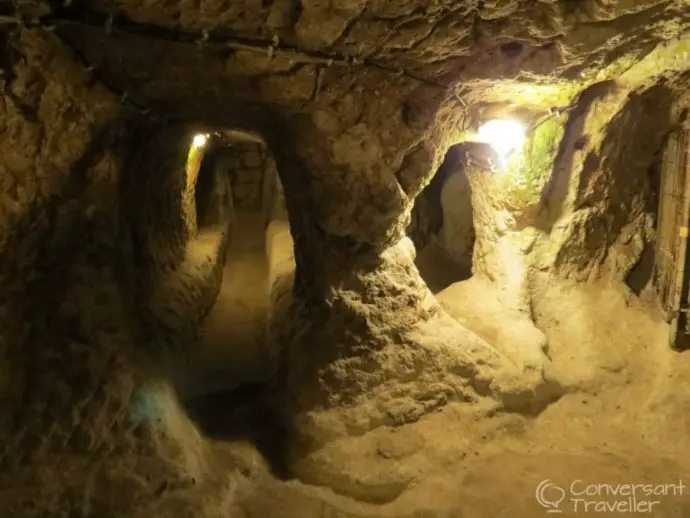
If we’d have done today by ourselves we would have come away with the same lovely photos, possibly spent longer in the Soganli Valley and walked a little further, and no doubt spent the day swearing at each other when the nagivation didn’t go quite to plan. Instead we learnt more in a day than we could ever hope to absorb from a guide book (and lets be honest, we all flick right past the history bit straight to the accommodation and restaurant section, right?), and dare we say it, actually enjoyed a bit of good company! Turkish Heritage were professional from the outset, and truly deserve their glowing reputation.
TIPS:
Mustafapasa – more of a quick stop on the way to somewhere else, there are pulic toilets here, and a few shops.
Sobessos – there is no entrance fee here, just a donation box for those so inclined. The site isn’t staffed unless work is going on and there are no facilities of any kind. You can see everything in about 10 – 15 minutes.
Soganli Valley – there are lots of cave churches to see, but if short on time (or just getting to saturation point with them!) you’ll get the picture with just 2 or 3. There are toilets at the cafe in Soganli Village. Ladies often hang around at the valley entrance with locally crafted dolls to sell to supplement their incomes, so if you have some change on you, spare them a thought.
Derinkuyu Underground City – this is a little less visited than the other more well known city at Kaymakli. There was virtually no-one else there when we visited in February but I can imagine in the height of summer with lots of tour groups passing through it won’t be a place for those with claustrophobic tendancies. Some of the passageways are so long and narrow that you could get half way down, only to have to turn around and retrace your steps to allow another group past. Ferai did say they tend to yell down first to make sure no-one is coming up before descending, but if that system doesn’t work to say you’ll be getting a bit of a workout would be an understatement! It is cold down below, so take a jumper or light jacket, but with all the climbing of stairs you do get hot!
Tour Payment – make sure you have your cash with you to pay at the office after the tour. We mistakenly assumed we’d be paying at the Kelebek hotel on check out since it was booked via them. Tipping isn’t necessary but certainly appreciated. The bus will drop you off back at your hotel.


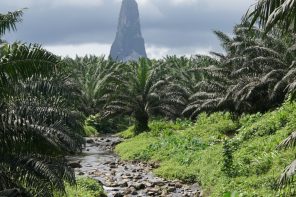
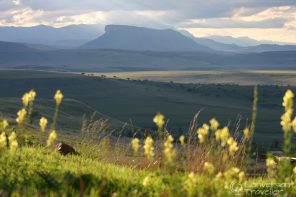
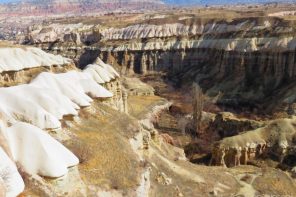
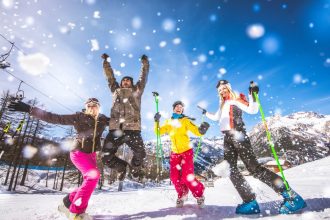
It is just a gorgeous place and I went to the same places that you have been. Everything was just great.
Certainly one of the most geologically stunning places I’ve ever been.
I had the opportunity to go to Cappodocia a few years ago when me and my then-boyfriend took a holiday to Side in Southern Turkey, and I’ve kicked myself that I didn’t ever since. Something about the place just completely captivates me; the ‘traditional’ hot air balloon rides, the history, the clay-pot food! GARGH. This post hasn’t helped my jealousy one bit, may I add! Lovely photos, and on the rest of your posts too 🙂
This Girl Loves
Thanks Sara, Cappadocia is really like no-where else on earth, and somewhere you really have to go one day! It’s one of those places that live up to (and beyond) all expectations, and despite some nice pics (thanks :-)) even they don’t do it justice!